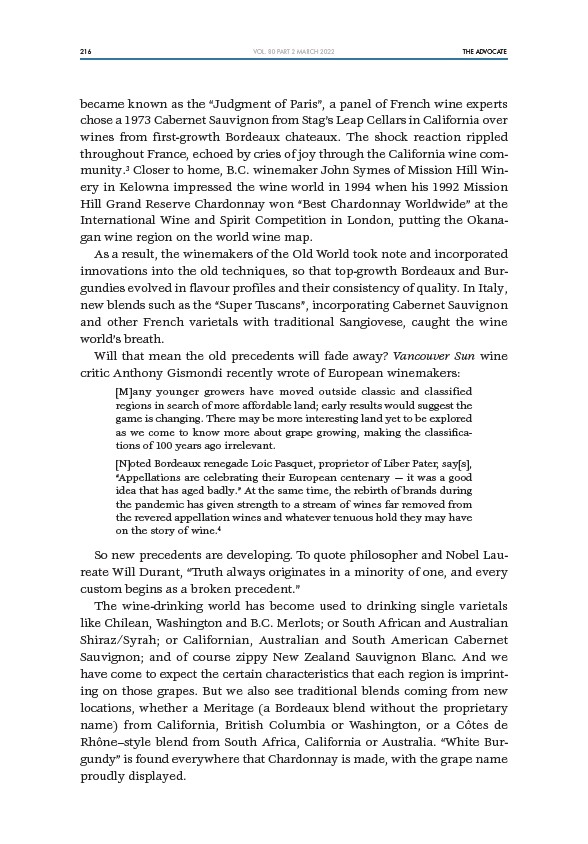
216 THE ADVOCATE
VOL. 80 PART 2 MARCH 2022
became known as the “Judgment of Paris”, a panel of French wine experts
chose a 1973 Cabernet Sauvignon from Stag’s Leap Cellars in California over
wines from first-growth Bordeaux chateaux. The shock reaction rippled
throughout France, echoed by cries of joy through the California wine community.
3 Closer to home, B.C. winemaker John Symes of Mission Hill Winery
in Kelowna impressed the wine world in 1994 when his 1992 Mission
Hill Grand Reserve Chardonnay won “Best Chardonnay Worldwide” at the
International Wine and Spirit Competition in London, putting the Okanagan
wine region on the world wine map.
As a result, the winemakers of the Old World took note and incorporated
innovations into the old techniques, so that top-growth Bordeaux and Burgundies
evolved in flavour profiles and their consistency of quality. In Italy,
new blends such as the “Super Tuscans”, incorporating Cabernet Sauvignon
and other French varietals with traditional Sangiovese, caught the wine
world’s breath.
Will that mean the old precedents will fade away? Vancouver Sun wine
critic Anthony Gismondi recently wrote of European winemakers:
Many younger growers have moved outside classic and classified
regions in search of more affordable land; early results would suggest the
game is changing. There may be more interesting land yet to be explored
as we come to know more about grape growing, making the classifications
of 100 years ago irrelevant.
Noted Bordeaux renegade Loic Pasquet, proprietor of Liber Pater, says,
“Appellations are celebrating their European centenary — it was a good
idea that has aged badly.” At the same time, the rebirth of brands during
the pandemic has given strength to a stream of wines far removed from
the revered appellation wines and whatever tenuous hold they may have
on the story of wine.4
So new precedents are developing. To quote philosopher and Nobel Laureate
Will Durant, “Truth always originates in a minority of one, and every
custom begins as a broken precedent.”
The wine-drinking world has become used to drinking single varietals
like Chilean, Washington and B.C. Merlots; or South African and Australian
Shiraz/Syrah; or Californian, Australian and South American Cabernet
Sauvignon; and of course zippy New Zealand Sauvignon Blanc. And we
have come to expect the certain characteristics that each region is imprinting
on those grapes. But we also see traditional blends coming from new
locations, whether a Meritage (a Bordeaux blend without the proprietary
name) from California, British Columbia or Washington, or a Côtes de
Rhône–style blend from South Africa, California or Australia. “White Burgundy”
is found everywhere that Chardonnay is made, with the grape name
proudly displayed.